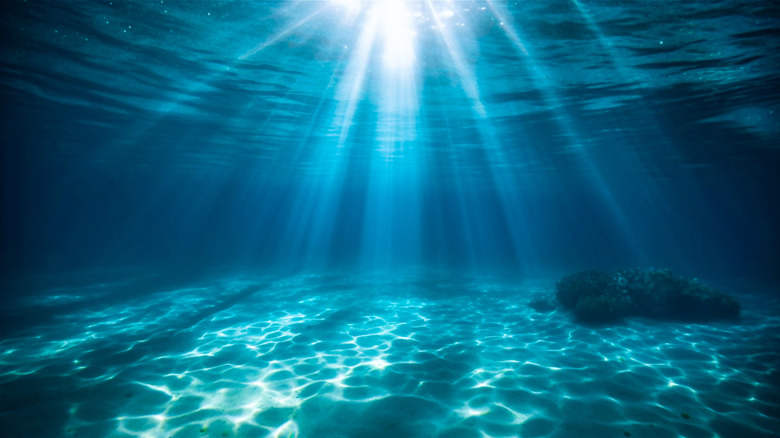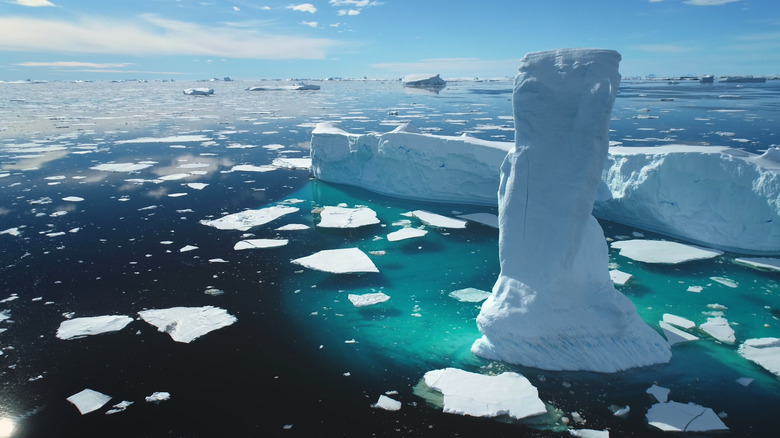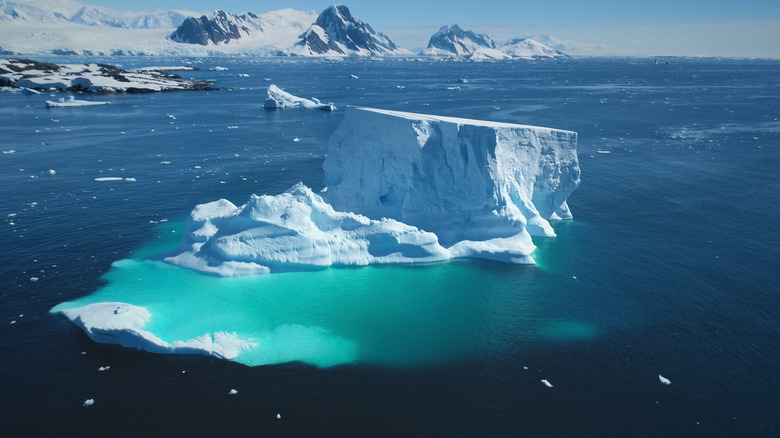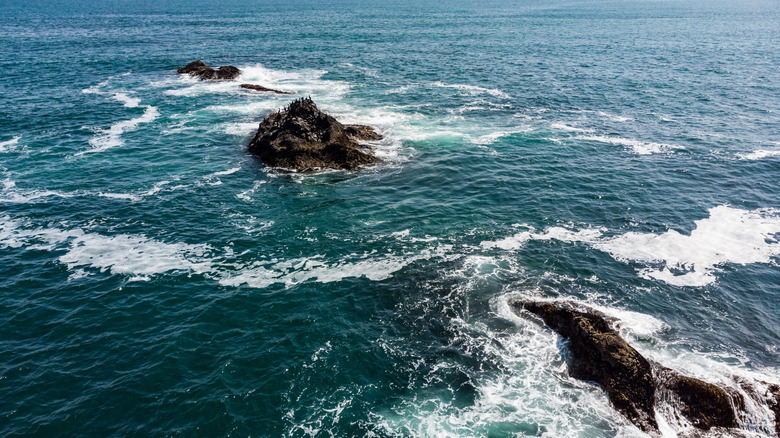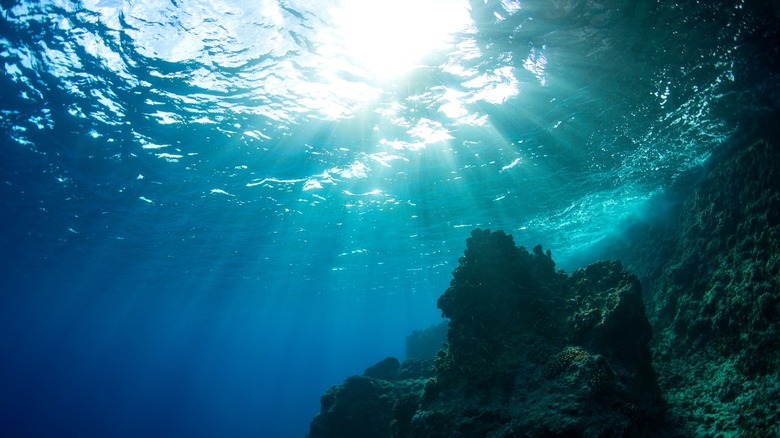Top 5 Strangest Sounds Ever Captured In The Ocean
The urge to explore the cosmos has always been an irrepressible part of humankind's curiosity. But while venturing into space in search of life elsewhere in the universe will remain one of the most fascinating projects humans undertake, there is a vast and infinitely perplexing mystery right here on planet Earth. The ocean covers around 70% of our planet's surface, yet it remains largely unexplored by human beings.
Though scientists and researchers are discovering more about the ocean all the time, it still remains one big mystery. For some time, it was thought that the deep ocean was barren and incapable of hosting any kind of life, but now we know the depths host bizarre, almost alien lifeforms. Scientists have already found life in strange places in the Pacific Ocean, as was the case in a 2023 study by Natural History Museum scientists (via the BBC), which revealed more than 5,000 previously unknown creatures living in the Clarion-Clipperton Zone of the Pacific Ocean.
But while alien-like species previously unknown to science are both fascinating and a little creepy, nothing is quite so unsettling as the mystery sounds of the ocean. In the past few decades, numerous rumblings from the depths have been recorded, and to say they're a little eerie is to understate things dramatically. Here are the five strangest sounds ever captured in the ocean.
A quacking conversation between mystery animals
All the while scientists are finding alien probes and searching for life on other planets, there is a whole alien world beneath the world's oceans. Sometimes, that world produces strange sounds that are recorded by humans, such as when researchers in New Zealand heard an unidentifiable repeating sound during an investigation into the South Fiji Basin — a deep basin in the South West Pacific with a floor that lies between 4,000 and 4,700 meters below sea level.
In July 1982, this team of researchers used an array of hydrophones (devices that record ocean sounds from all directions) towed behind a ship to record around the South Fiji Basin, and picked up four short "quacks." While the team ultimately came to the conclusion that the bursts of sound came from a biological source, nobody could identify that source, nor what the sounds meant. As research team member Ross Chapman, from the University of Victoria, told Phys.org, "The sound was so repeatable, we couldn't believe at first that it was biological. But in talking to other colleagues in Australia about the data, we discovered that a similar sound was heard quite often in other regions around New Zealand and Australia."
Still, the sounds remain unidentified to this day, despite theories that suggest the "Bio-duck" sound — as it was initially named — came from Antarctic Minke whales. Whatever made the quacks, Chapman himself believes the sound could actually represent some sort of "conversation" between multiple animals. He explained, "We discovered that there were usually several different speakers at different places in the ocean, and all of them making these sounds. The most amazing thing was that when one speaker was talking, the others were quiet, as though they were listening."
The Bloop
As spooky science stories go, the "Bloop" isn't quite as unsettling as it once was, thanks to studies that finally revealed the source of this strange ocean sound. But back in 1997, this bizarre rumbling, recorded in the southern Pacific, had National Oceanic and Atmospheric Administration (NOAA) researchers stumped. The group had been listening for underwater volcanic activity when their hydrophones recorded a powerful noise that was unlike anything ever recorded before.
The rumble, which can be heard on NOAA's website, contained a unique quality that was dubbed "the Bloop," prompting multiple theories as to what could have caused it. These theories included some sort of secret military exercise, fishing boat winches, giant squids, and even some previously unidentified sea creature from the depths of the ocean.
However, the mystery was solved in 2005, when scientists from NOAA's Pacific Marine Environmental Laboratory (PMEL) discovered the bloop had been caused by icebergs breaking away from an Antarctic glacier. Known as an icequake, this revelation was only discovered after PMEL researchers used hydrophones that were close enough to Antarctica to actually identify the source of the mysterious "bloop." Still, the strange sound had managed to baffle scientists for almost a decade.
Slow Down
In May 1997, PMEL's hydrophone array, located in the eastern equatorial Pacific Ocean, recorded a sound just off the Antarctic Peninsula in an area populated by islands and shoals. This mystery sound became known as "Slow Down" due to the fact it slowly descends in frequency for a duration of around seven minutes. A sped-up version of the sound itself can be heard on NOAA's website, and it's about as creepy as you could possibly imagine, sounding like the soundtrack to some slow descent into hell.
So intense was this sound that it was picked up by three sensors almost 3,100 miles (5,000 km) apart. While the source has never been confirmed, NOAA believes that it was caused by an iceberg drifting to a slow stop as it became grounded on the seafloor. The administration therefore classifies "Slow Down," along with "The Bloop," as a cryogenic sound caused by ice. But the sound has never been officially identified, adding to the overall eeriness of this strange deep ocean tone.
Upsweep
The Acoustics Program within NOAA's Pacific Marine Environmental Laboratory started all the way back in 1991. It was set up to create digital records of ocean ambient sound, and almost immediately resulted in the recording of a uniquely chilling tone. If you want to hear something that sounds like some sort of ungodly alarm ringing through a gateway to the beyond, "Upsweep" is everything you're looking for. This upsetting reverberation, which can be heard on the PMEL website, was recorded back in August 1991 when the laboratory began using the Sound Surveillance System (SOSUS). According to the organization, the sound consists of "narrow-band upsweeping sounds," each lasting several seconds.
These tones can be heard throughout the Pacific, and reach their peak in spring and fall. Why? Well, nobody really knows, but PMEL suggests it could be due to seasonal changes in the environment itself, if not unknown changes in the sound source itself. While the source of "Upsweep" has been identified as being near "inferred volcanic seismicity," the actual specific origin of this infernal cacophony remains unconfirmed.
Adding to the mystery is the fact that NOAA has observed the overall level of the sound declining ever since it was recorded for the first time in 1991. Again, explanations for why remain elusive, making this one of the strangest sounds yet discovered in the ocean.
Whistle
Another puzzling example from 1997, the NOAA calls this particular sound "Submarine Volcanic Eruption." But as the administration itself notes, this particular tone was only recorded on one hydrophone, making it impossible to actually locate the source of the sound. As such, "Submarine Volcanic Eruption," otherwise known as "Whistle," remains somewhat of a mystery, as the sound itself was likely detected at a great distance from its source volcano.
Described as an "undulating single frequency," "Whistle" is very similar to other signals produced by volcanoes below the ocean's surface. As NOAA points out, eastern Pacific hydrophone arrays have previously detected volcanic signals that closely resemble "Whistle" emanating from the Mariana volcanic arc — a chain of active volcanoes in the western Pacific Ocean, north of Guam.
The sound itself, available to listen to here, is less like a whistle and more like a deep moan. While not quite as soul-chilling as "Upsweep," it is creepy enough to conjure images of some sort of eldritch beast rising from the depths, even if it really does come from some unidentified volcano preparing to erupt — not that the latter is any less concerning.
